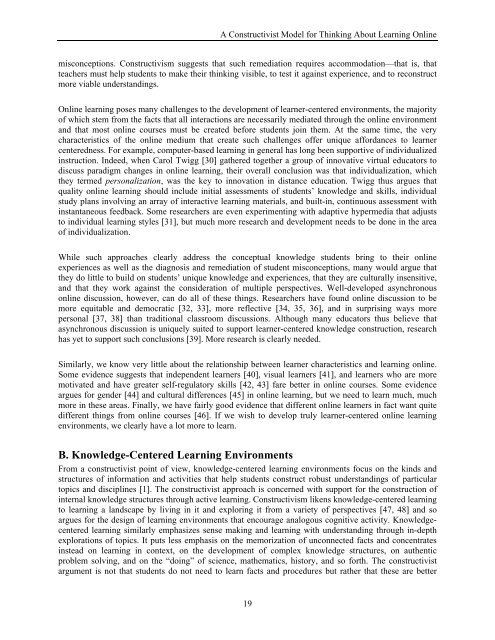Elements of Quality Online Education cation
Elements of Quality Online Education cation
Elements of Quality Online Education cation
You also want an ePaper? Increase the reach of your titles
YUMPU automatically turns print PDFs into web optimized ePapers that Google loves.
A Constructivist Model for Thinking About Learning <strong>Online</strong>misconceptions. Constructivism suggests that such remediation requires accommodation—that is, thatteachers must help students to make their thinking visible, to test it against experience, and to reconstructmore viable understandings.<strong>Online</strong> learning poses many challenges to the development <strong>of</strong> learner-centered environments, the majority<strong>of</strong> which stem from the facts that all interactions are necessarily mediated through the online environmentand that most online courses must be created before students join them. At the same time, the verycharacteristics <strong>of</strong> the online medium that create such challenges <strong>of</strong>fer unique affordances to learnercenteredness. For example, computer-based learning in general has long been supportive <strong>of</strong> individualizedinstruction. Indeed, when Carol Twigg [30] gathered together a group <strong>of</strong> innovative virtual educators todiscuss paradigm changes in online learning, their overall conclusion was that individualization, whichthey termed personalization, was the key to innovation in distance edu<strong>cation</strong>. Twigg thus argues thatquality online learning should include initial assessments <strong>of</strong> students’ knowledge and skills, individualstudy plans involving an array <strong>of</strong> interactive learning materials, and built-in, continuous assessment withinstantaneous feedback. Some researchers are even experimenting with adaptive hypermedia that adjuststo individual learning styles [31], but much more research and development needs to be done in the area<strong>of</strong> individualization.While such approaches clearly address the conceptual knowledge students bring to their onlineexperiences as well as the diagnosis and remediation <strong>of</strong> student misconceptions, many would argue thatthey do little to build on students’ unique knowledge and experiences, that they are culturally insensitive,and that they work against the consideration <strong>of</strong> multiple perspectives. Well-developed asynchronousonline discussion, however, can do all <strong>of</strong> these things. Researchers have found online discussion to bemore equitable and democratic [32, 33], more reflective [34, 35, 36], and in surprising ways morepersonal [37, 38] than traditional classroom discussions. Although many educators thus believe thatasynchronous discussion is uniquely suited to support learner-centered knowledge construction, researchhas yet to support such conclusions [39]. More research is clearly needed.Similarly, we know very little about the relationship between learner characteristics and learning online.Some evidence suggests that independent learners [40], visual learners [41], and learners who are moremotivated and have greater self-regulatory skills [42, 43] fare better in online courses. Some evidenceargues for gender [44] and cultural differences [45] in online learning, but we need to learn much, muchmore in these areas. Finally, we have fairly good evidence that different online learners in fact want quitedifferent things from online courses [46]. If we wish to develop truly learner-centered online learningenvironments, we clearly have a lot more to learn.B. Knowledge-Centered Learning EnvironmentsFrom a constructivist point <strong>of</strong> view, knowledge-centered learning environments focus on the kinds andstructures <strong>of</strong> information and activities that help students construct robust understandings <strong>of</strong> particulartopics and disciplines [1]. The constructivist approach is concerned with support for the construction <strong>of</strong>internal knowledge structures through active learning. Constructivism likens knowledge-centered learningto learning a landscape by living in it and exploring it from a variety <strong>of</strong> perspectives [47, 48] and soargues for the design <strong>of</strong> learning environments that encourage analogous cognitive activity. Knowledgecenteredlearning similarly emphasizes sense making and learning with understanding through in-depthexplorations <strong>of</strong> topics. It puts less emphasis on the memorization <strong>of</strong> unconnected facts and concentratesinstead on learning in context, on the development <strong>of</strong> complex knowledge structures, on authenticproblem solving, and on the “doing” <strong>of</strong> science, mathematics, history, and so forth. The constructivistargument is not that students do not need to learn facts and procedures but rather that these are better19
















